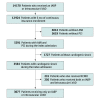Clinical Outcomes and Cost Associated With an Intravascular Microaxial Left Ventricular Assist Device vs Intra-aortic Balloon Pump in Patients Presenting With Acute Myocardial Infarction Complicated by Cardiogenic Shock
- PMID: 35849410
- PMCID: PMC9295019
- DOI: 10.1001/jamainternmed.2022.2735
Clinical Outcomes and Cost Associated With an Intravascular Microaxial Left Ventricular Assist Device vs Intra-aortic Balloon Pump in Patients Presenting With Acute Myocardial Infarction Complicated by Cardiogenic Shock
Abstract
Importance: Intravascular microaxial left ventricular assist device (LVAD) compared with intra-aortic balloon pump (IABP) has been associated with increased risk of mortality and bleeding among patients with acute myocardial infarction (AMI) and cardiogenic shock (CS) undergoing percutaneous coronary intervention (PCI). However, evidence on the association of device therapy with a broader array of clinical outcomes, including data on long-term outcomes and cost, is limited.
Objective: To examine the association between intravascular LVAD or IABP use and clinical outcomes and cost in patients with AMI complicated by CS.
Design, setting, and participants: This retrospective propensity-matched cohort study used administrative claims data for commercially insured patients from 14 states across the US. Patients included in the analysis underwent PCI for AMI complicated by CS from January 1, 2015, to April 30, 2020. Data analysis was performed from April to November 2021.
Exposures: Use of either an intravascular LVAD or IABP.
Main outcomes and measures: The primary outcomes were mortality, stroke, severe bleeding, repeat revascularization, kidney replacement therapy (KRT), and total health care costs during the index admission. Clinical outcomes and cost were also assessed at 30 days and 1 year.
Results: Among 3077 patients undergoing PCI for AMI complicated by CS, the mean (SD) age was 65.2 (12.5) years, and 986 (32.0%) had cardiac arrest. Among 817 propensity-matched pairs, intravascular LVAD use was associated with significantly higher in-hospital (36.2% vs 25.8%; odds ratio [OR], 1.63; 95% CI, 1.32-2.02), 30-day (40.1% vs 28.3%; OR, 1.71; 95% CI, 1.37-2.13), and 1-year mortality (58.9% vs 45.0%; hazard ratio [HR], 1.44; 95% CI, 1.21-1.71) compared with IABP. At 30 days, intravascular LVAD use was associated with significantly higher bleeding (19.1% vs 14.5%; OR, 1.35; 95% CI, 1.04-1.76), KRT (12.2% vs 7.0%; OR, 1.88; 95% CI, 1.30-2.73), and mean cost (+$51 680; 95% CI, $31 488-$75 178). At 1 year, the association of intravascular LVAD use with bleeding (29.7% vs 24.3%; HR, 1.36; 95% CI, 1.05-1.75), KRT (18.1% vs 10.9%; HR, 1.95; 95% CI, 1.35-2.83), and mean cost (+$46 609; 95% CI, $22 126-$75 461) persisted.
Conclusions and relevance: In this propensity-matched analysis of patients undergoing PCI for AMI complicated by CS, intravascular LVAD use was associated with increased short-term and 1-year risk of mortality, bleeding, KRT, and cost compared with IABP. There is an urgent need for additional evidence surrounding the optimal management of patients with AMI complicated by CS.
Conflict of interest statement
Figures




Comment in
-
Intravascular Microaxial Left Ventricular Assist Device for Acute Myocardial Infarction With Cardiogenic Shock-A Call for Evidence of Benefit.JAMA Intern Med. 2022 Sep 1;182(9):903-905. doi: 10.1001/jamainternmed.2022.2734. JAMA Intern Med. 2022. PMID: 35849388 No abstract available.
-
Caution With Conclusions and Context of Mechanical Circulatory Devices.JAMA Intern Med. 2023 Mar 1;183(3):277. doi: 10.1001/jamainternmed.2022.6168. JAMA Intern Med. 2023. PMID: 36648854 No abstract available.
-
Caution With Conclusions and Context of Mechanical Circulatory Devices-Reply.JAMA Intern Med. 2023 Mar 1;183(3):277-278. doi: 10.1001/jamainternmed.2022.6171. JAMA Intern Med. 2023. PMID: 36648933 No abstract available.
-
Mechanical circulatory support in cardiogenic shock: it is not just a matter of device.J Cardiovasc Med (Hagerstown). 2023 Apr 1;24(4):230-231. doi: 10.2459/JCM.0000000000001452. J Cardiovasc Med (Hagerstown). 2023. PMID: 36952388 No abstract available.
References
-
- van Diepen S, Katz JN, Albert NM, et al. ; American Heart Association Council on Clinical Cardiology; Council on Cardiovascular and Stroke Nursing; Council on Quality of Care and Outcomes Research; and Mission: Lifeline . Contemporary management of cardiogenic shock: a scientific statement from the American Heart Association. Circulation. 2017;136(16):e232-e268. doi:10.1161/CIR.0000000000000525 - DOI - PubMed
-
- Seyfarth M, Sibbing D, Bauer I, et al. . A randomized clinical trial to evaluate the safety and efficacy of a percutaneous left ventricular assist device versus intra-aortic balloon pumping for treatment of cardiogenic shock caused by myocardial infarction. J Am Coll Cardiol. 2008;52(19):1584-1588. doi:10.1016/j.jacc.2008.05.065 - DOI - PubMed
MeSH terms
Grants and funding
LinkOut - more resources
Full Text Sources
Medical
Research Materials
Miscellaneous

